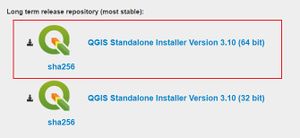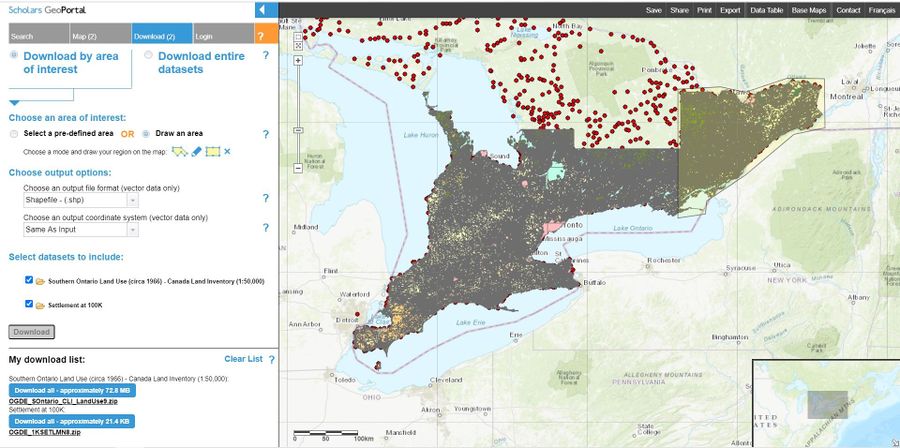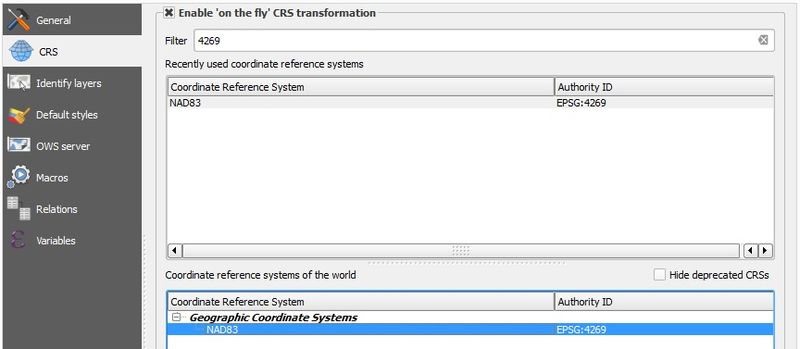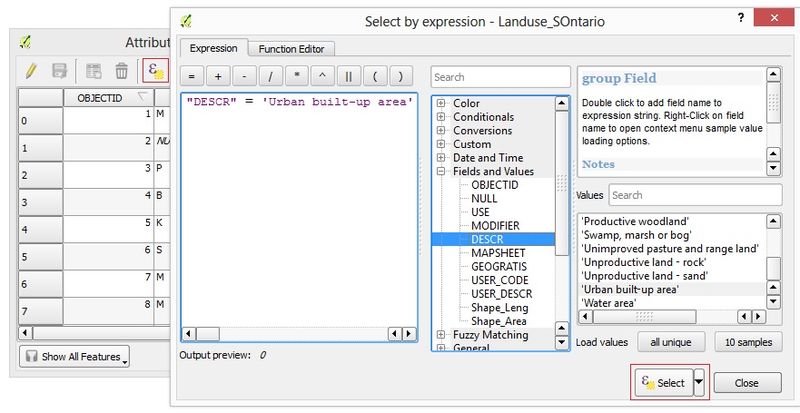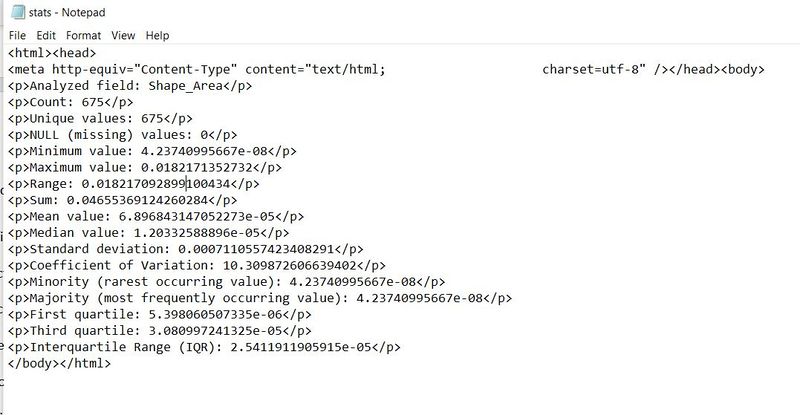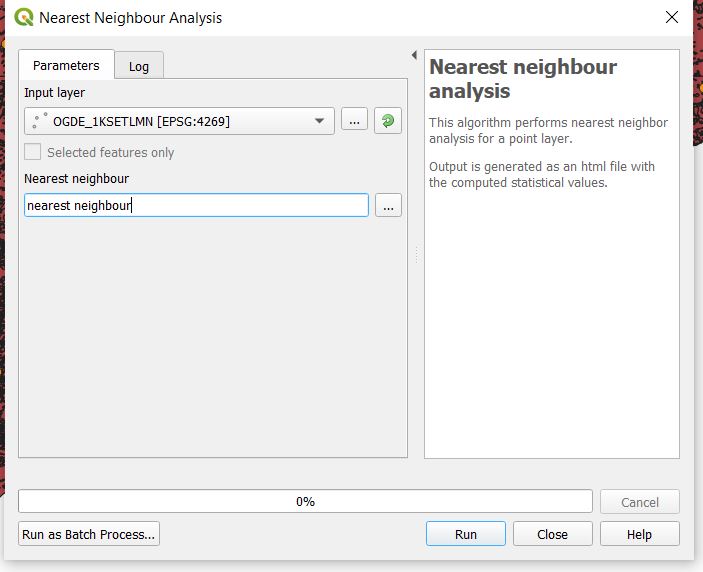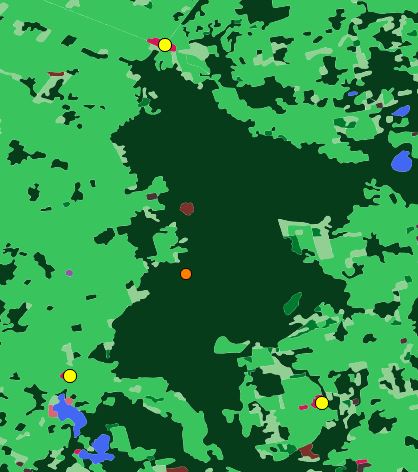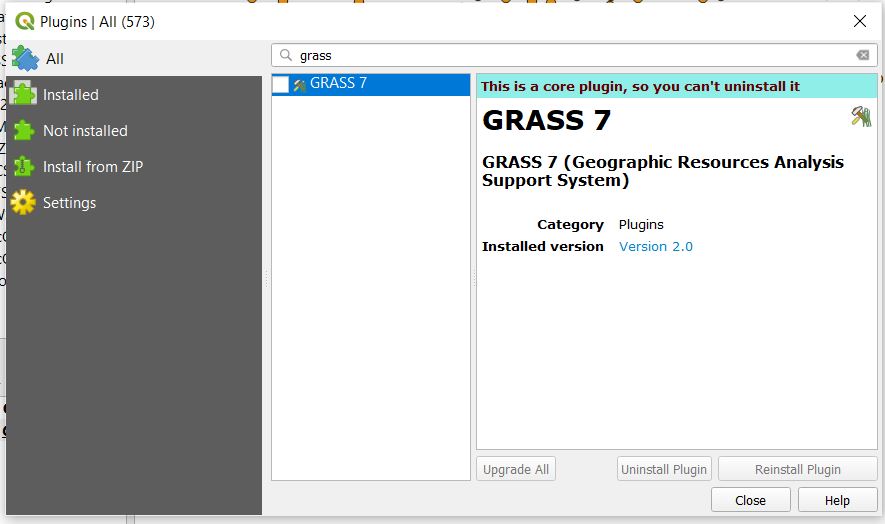Difference between revisions of "Exploring Standard Statistics in QGIS"
| (39 intermediate revisions by 5 users not shown) | |||
| Line 1: | Line 1: | ||
== Purpose == |
== Purpose == |
||
| − | The purpose of this Wiki tutorial is to present the user with further information on the basic spatial statistic tools available within QGIS. Step by step instruction will demonstrate how each tool can be used to perform statistical analysis on vector datasets. Furthermore, this tutorial will not cover detailed explanations on how to use project specific statistical tools (i.e. hydrological and terrain tools) as there are tutorials focused specifically on those toolsets that can be found on the main Wiki page. Instead there will be descriptions of these standard statistical tools and discussion on what they are typically used for. This tutorial will also touch on the limitations of such tools in QGIS and how the integration of other open source software can reduce these limitations. |
+ | The purpose of this Wiki tutorial is to present the user with further information on the basic spatial statistic tools available within QGIS. Step by step instruction will demonstrate how each tool can be used to perform statistical analysis on vector datasets. Furthermore, this tutorial will not cover detailed explanations on how to use project specific statistical tools (i.e. hydrological and terrain tools) as there are tutorials focused specifically on those toolsets that can be found on the main Wiki page. Instead, there will be descriptions of these standard statistical tools and discussion on what they are typically used for. This tutorial will also touch on the limitations of such tools in QGIS and how the integration of other open source software can reduce these limitations. |
| − | |||
== Introduction == |
== Introduction == |
||
| − | Geospatial analysis composes the root of all geosciences. Spatial statistics were uniquely created to analyze vector data in order to find patterns and relationships within a distribution |
+ | Geospatial analysis composes the root of all geosciences. Spatial statistics were uniquely created to analyze vector data in order to find patterns and relationships within a distribution. This characteristic is what makes GIS software such a powerful tool. Standard spatial statistic tools that are available within QGIS include basic statistics, nearest neighbour analysis and mean coordinates. The main focus in the following tutorial will be to provide instruction on how to use these statistical tools. These standard statistical tools are advantageous to any user who is attempting to further understand a vector dataset apart from the initial visual representation. Although simple, standard statistical tools are arguably the most valuable when analyzing a new dataset. QGIS is a very powerful free open source software (FOSS) but it still has its limitations. Integration of a second FOSS, GRASSGIS, can introduce ways of dealing with more complex statistical problems and close the gap on some limitations within QGIS. |
| − | |||
== Materials == |
== Materials == |
||
===About QGIS=== |
===About QGIS=== |
||
| − | Quantum GIS, better known and QGIS, is arguably the most powerful and commonly used free open source geographic information system software available. It allows the user to create, edit, visually represent, analyze and publish information. It is available for download on a variety of operating systems from Windows, Mac, Linux and BSD with recent efforts working towards compatibility with Android. QGIS is licensed under the Creative Commons Attribution-ShareAlike 3.0 license (CC BY-SA). |
+ | Quantum GIS, better known and QGIS, is arguably the most powerful and commonly used free open source geographic information system software available. It allows the user to create, edit, visually represent, analyze and publish information. It is available for download on a variety of operating systems from Windows, Mac, Linux and BSD, with recent efforts working towards compatibility with Android. QGIS is licensed under the Creative Commons Attribution-ShareAlike 3.0 license (CC BY-SA). |
====Download QGIS==== |
====Download QGIS==== |
||
| − | + | This tutorial was originally done with version of QGIS is 2.12.1 Lyon which was released on November 27, 2015. But during the revision, the tutorial was done using QGIS 3.10.10. It is available for download on their [https://qgis.org/en/site/forusers/download.html Official Website] . Download and install the current version of QGIS for your operating system in order to follow along with the following step-by-step tutorial. |
|
| + | [[File:A.jpg|thumb|Fig 1. Screenshot of the version used during revision of this tutorial. ]] |
||
====Data Acquisition==== |
====Data Acquisition==== |
||
| − | There are numerous resources available to acquire spatial data for use within GIS software such as the Ottawa Open Data Catalogue and Scholars GeoPortal. For the purposes of this tutorial, we will be using data taken from the Scholars GeoPortal which is accessible online using your Carleton University student login through the MacOdrum Library website. The data required for this tutorial is the Ontario population data file entitled '''''Settlement at 100k''''' and the Ontario land use data entitled '''''Southern Ontario Land Use (Circa 1966) – Canada Land Inventory (1:50,000)'''''. |
+ | There are numerous resources available to acquire spatial data for use within GIS software; such as, the Ottawa Open Data Catalogue and Scholars GeoPortal. For the purposes of this tutorial, we will be using data taken from the Scholars GeoPortal, which is accessible online using your Carleton University student login through the MacOdrum Library website. The data required for this tutorial is the Ontario population data file entitled '''''Settlement at 100k''''' and the Ontario land use data entitled '''''Southern Ontario Land Use (Circa 1966) – Canada Land Inventory (1:50,000)'''''. |
| − | '''''Settlement at 100k''''': This is a point dataset marking locations of populated areas across the province of Ontario, Canada. |
+ | '''''Settlement at 100k''''': This is a point dataset marking locations of populated areas across the province of Ontario, Canada. |
| ⚫ | |||
| ⚫ | |||
| ⚫ | |||
| + | |||
| ⚫ | |||
# Under the '''''Search''''' tab, search and add the two datasets to your working map. |
# Under the '''''Search''''' tab, search and add the two datasets to your working map. |
||
| − | # Under the '''''Download''''' tab, select the '''''Download by area of interest''''' option then select '''''Draw an area''''' and choose the polygon shape as your mode of drawing. Manually select the area you want to download data for by drawing directly on the map. Double click to end your selection. |
+ | # Under the '''''Download''''' tab, select the '''''Download by area of interest''''' option then select '''''Draw an area''''' and choose the polygon shape as your mode of drawing. Manually select the area you want to download data for by drawing directly on the map. Double click to end your selection. Note: Be sure to draw a reasonable sized region, as a region too big may or may not be able to download. |
| − | ##[[File: |
+ | ##[[File:Area of Interest 1.jpg|900px|thumb|none|''Figure 2: Image of Scholars GeoPortal showing map selection of datasets ready for download.'']] |
#Click the download button in the bottom left hand corner of your screen. Below this button is your download list and is the location where your files will download to. |
#Click the download button in the bottom left hand corner of your screen. Below this button is your download list and is the location where your files will download to. |
||
#Once the files have completed downloading to your download list, click on each item to download them to your desktop. Note that these files are large and will need to be unzipped before being saved to your preferred location. |
#Once the files have completed downloading to your download list, click on each item to download them to your desktop. Note that these files are large and will need to be unzipped before being saved to your preferred location. |
||
| − | |||
== Tools and Methods == |
== Tools and Methods == |
||
| Line 41: | Line 40: | ||
##[[File:411.jpg|800px|thumb|none|''Figure 2: Project tab menu.'']] |
##[[File:411.jpg|800px|thumb|none|''Figure 2: Project tab menu.'']] |
||
# Choose the appropriate projection for your project, click '''''OK'''''. |
# Choose the appropriate projection for your project, click '''''OK'''''. |
||
| − | ##[[File:412.jpg|800px|thumb|none|''Figure 3: Project properties window showing project projection selection.'']]For more information on re-projecting data layers, click [http://docs.qgis.org/2.2/en/docs/user_manual/working_with_projections/working_with_projections.html |
+ | ##[[File:412.jpg|800px|thumb|none|''Figure 3: Project properties window showing project projection selection.'']]For more information on re-projecting data layers, click [http://docs.qgis.org/2.2/en/docs/user_manual/working_with_projections/working_with_projections.html here]. |
====Importing Data==== |
====Importing Data==== |
||
| Line 47: | Line 46: | ||
====Playing with Symbology==== |
====Playing with Symbology==== |
||
| − | Once your data layers have been added to your working project, take time to play with the symbology and express the data in a visual way that suits your needs. In this tutorial, the Land Use dataset was expressed in a more simplistic way by grouping similar land classes together and using a more appropriate colour scheme. For additional information on using symbology in QGIS, click [http://docs.qgis.org/2.0/en/docs/training_manual/basic_map/symbology.html |
+ | Once your data layers have been added to your working project, take time to play with the symbology and express the data in a visual way that suits your needs. In this tutorial, the Land Use dataset was expressed in a more simplistic way by grouping similar land classes together and using a more appropriate colour scheme. For additional information on using symbology in QGIS, click [http://docs.qgis.org/2.0/en/docs/training_manual/basic_map/symbology.html here]. |
---- |
---- |
||
===Basic Statistics=== |
===Basic Statistics=== |
||
| − | Basic statistics are a set of values calculated from a dataset known as, the mean, the mode, the median and standard deviation and are exactly what their name suggests, the most basic statistics. They form the basis of statistics and are some of the most valuable to calculate. Often used as tools for the organization on larger datasets. |
+ | Basic statistics are a set of values calculated from a dataset; known as, the mean, the mode, the median and standard deviation, and are exactly what their name suggests, the most basic statistics. They form the basis of statistics and are some of the most valuable to calculate. Often used as tools for the organization on larger datasets. |
Using the Land Use dataset, one might want to know the area of land in Southern Ontario that is classified as a particular land use. For example, the area of land considered to be built up urban area. |
Using the Land Use dataset, one might want to know the area of land in Southern Ontario that is classified as a particular land use. For example, the area of land considered to be built up urban area. |
||
# To do this, query to select all polygons from the data layer that are classified as build up urban area. This is done in the data layers attribute table. |
# To do this, query to select all polygons from the data layer that are classified as build up urban area. This is done in the data layers attribute table. |
||
| − | ##[[File:421.jpg|800px|thumb|none|''Figure |
+ | ##[[File:421.jpg|800px|thumb|none|''Figure 5: The Select by expression window in the attribute table used to query for desired attribute in a data layer.'']]For more information on querying in QGIS, click [http://docs.qgis.org/1.8/en/docs/user_manual/working_with_vector/query_builder.html here]. |
# Once your selection is complete, open the '''''Basic Statistics''''' window under the '''''Vector > Analysis Tools''''' tab. |
# Once your selection is complete, open the '''''Basic Statistics''''' window under the '''''Vector > Analysis Tools''''' tab. |
||
| − | ##[[File:422.jpg|800px|thumb|none|''Figure |
+ | ##[[File:422.jpg|800px|thumb|none|''Figure 6: Vector > Analysis Tools tab menu.'']] |
| − | # In the '''''Basic Statistics''''' window, select your layer of interest. Be sure to check the box '''''‘Use only selected features’'''''. The target field should be the field that the statistics are being calculated for, in the case of this tutorial, Area. Click ''''' |
+ | # In the '''''Basic Statistics''''' window, select your layer of interest. Be sure to check the box '''''‘Use only selected features’'''''. The target field should be the field that the statistics are being calculated for, in the case of this tutorial, Area. Click '''''RUN'''''. |
| − | ##[[File: |
+ | ##[[File:Stats.jpg|800px|thumb|none|''Figure 7: Basic Statistics Window showing statistics for area of urban land use in Southern Ontario.'']] |
| − | Results will be shown in the units that correspond to your project projection. In the case of this tutorial, area statistics are displayed in |
+ | Results will be shown in the units that correspond to your project projection. In the case of this tutorial, area statistics are displayed in m<sup>2</sup>, where total area is the sum at 0.0465 m<sup>2</sup> |
| + | You can pull up the results by following copying the file path in the results viewer and pasting in file explorer. See below my results |
||
| − | |||
| + | #[[File:Resultss.jpg|800px|thumb|none|''Figure 8: Results of Basic Statistics .'']] |
||
---- |
---- |
||
===Nearest Neighbour Analysis=== |
===Nearest Neighbour Analysis=== |
||
| − | Nearest neighbour analysis, similar to the Distance Matrix tool, is a tool that calculates the mean distance of all point files in a data layer to the next nearest point. Output results of this tool include |
+ | Nearest neighbour analysis, similar to the Distance Matrix tool, is a tool that calculates the mean distance of all point files in a data layer to the next nearest point. Output results of this tool include: Observed Mean Distance, Expected Mean Distance, Nearest Neighbour Index, N and Z-Score. These values are typically used in distribution modeling and cluster analysis. |
In this tutorial we want to know the mean distance that is observed between all population settlements to try and understand their distribution in Southern Ontario. |
In this tutorial we want to know the mean distance that is observed between all population settlements to try and understand their distribution in Southern Ontario. |
||
# Open the '''''Nearest Neighbour Analysis''''' window under the '''''Vector > Analysis Tools''''' tab. |
# Open the '''''Nearest Neighbour Analysis''''' window under the '''''Vector > Analysis Tools''''' tab. |
||
##[[File:432.jpg|800px|thumb|none|''Figure 7: Nearest neighbour tool under the analysis tools menu.'']] |
##[[File:432.jpg|800px|thumb|none|''Figure 7: Nearest neighbour tool under the analysis tools menu.'']] |
||
| − | # Select the appropriate input vector layer, click ''''' |
+ | # Select the appropriate input vector layer, click '''''RUN'''''. |
| − | ##[[File: |
+ | ##[[File:nn.jpg|800px|thumb|none|''Figure 8: Nearest neighbour analysis window.'']] |
| − | Results of this analysis are valuable, however, under the current projection the output distance is given in degrees. If meter units are desired, the data layers would have to be re-projected to a different map projection before nearest neighbour analysis is performed. |
+ | Results of this analysis are valuable, however, under the current projection the output distance is given in degrees. If meter units are desired, the data layers would have to be re-projected to a different map projection before nearest neighbour analysis is performed. Like in the previous section, if you wanted your result from the nearest neighbour analysis you'd have to go the results viewer and copy the file path and then paste it into file explorer and open the result using any notepad. |
---- |
---- |
||
===Mean Coordinates=== |
===Mean Coordinates=== |
||
| − | Mean coordinates is an analysis that identifies the mean |
+ | Mean coordinates is an analysis that identifies the mean ( average) location of specific points in space or a geographic centre. This tool creates a new point file as a means of representing the output location. |
A basic use of this tool could be as simple as determining an area located equally between three known populations to create new cropland. |
A basic use of this tool could be as simple as determining an area located equally between three known populations to create new cropland. |
||
| − | # Select the point locations that you wish to find the mean coordinates of. This can be done via query in the attribute table as we previously |
+ | # Select the point locations that you wish to find the mean coordinates of. This can be done via query in the attribute table as we previously carried out in section 4.1, or the locations can be manually selected using the Select features by area or single click tool on the '''''Attributes Toolbar'''''. For multiple feature selection, select while simultaneously holding the Ctrl button on your keyboard. |
##[[File:442.jpg|800px|thumb|none|''Figure 9: Attributes Toolbar with red box highlighting the Select features by area of single click tool.'']] |
##[[File:442.jpg|800px|thumb|none|''Figure 9: Attributes Toolbar with red box highlighting the Select features by area of single click tool.'']] |
||
##[[File:443.jpg|800px|thumb|none|''Figure 10: Image clip of the working map. Yellow circles indicating manually selected population locations.'']] |
##[[File:443.jpg|800px|thumb|none|''Figure 10: Image clip of the working map. Yellow circles indicating manually selected population locations.'']] |
||
| Line 91: | Line 91: | ||
# The resulting output shapefile represents the mean coordinate point of the three locations. This is the location that the new crops will be made. X and Y coordinates of this centre point can be down in the point files attribute table. |
# The resulting output shapefile represents the mean coordinate point of the three locations. This is the location that the new crops will be made. X and Y coordinates of this centre point can be down in the point files attribute table. |
||
##[[File:446.JPG|800px|thumb|none|''Figure 14: Table showing spatial coordinates for the mean coordinate output.'']] |
##[[File:446.JPG|800px|thumb|none|''Figure 14: Table showing spatial coordinates for the mean coordinate output.'']] |
||
| − | |||
== Integration with GRASS == |
== Integration with GRASS == |
||
One of the main complaints people have about QGIS is simply its layout. Many of the tools are found under categories they may not belong in or would be more appropriate under another category. |
One of the main complaints people have about QGIS is simply its layout. Many of the tools are found under categories they may not belong in or would be more appropriate under another category. |
||
The program also used to have limited documentation help, but over the past few upgrades, the documentation has improved greatly. |
The program also used to have limited documentation help, but over the past few upgrades, the documentation has improved greatly. |
||
| − | Although the program has many tools to choose from, depending on the project the user is working on, the tools may not be well suited for it or just lacking enough options. This limitation can be resolved with the integration of another software. QGIS offers approximately 400 different plugins. In this case, QGIS is compatible with GRASS and |
+ | Although the program has many tools to choose from, depending on the project the user is working on, the tools may not be well suited for it or just lacking enough options. This limitation can be resolved with the integration of another software. QGIS offers approximately 400 different plugins. In this case, QGIS is compatible with GRASS and integration helps to improve its capabilities. |
===About GRASS=== |
===About GRASS=== |
||
| − | + | For this Tutorial, QGIS is 3.10.10 was used. This version of QGIS is available with integration of GRASS version 7.8.3. When downloading the desktop version of QGIS, it comes with a separate interface that has the GRASS plugin. |
|
| − | ##[[File: |
+ | ##[[File:Plug.jpg|900px|thumb|none|''Figure 15: The plugin access to GRASS in QGIS '']] |
| ⚫ | When opening the proper QGIS interface, there are many different plugins to choose from. When selecting the GRASS plugin, we have access to new analysis tools. You can upload GRASS data and mapsets, and use both QGIS tools and GRASS tools on it. Additionally, it works the other way around as well. You can upload QGIS data and mapsets and use both QGIS and GRASS tools on them. |
||
| − | |||
| ⚫ | When opening the proper QGIS interface, there are many different plugins to choose from. When selecting the GRASS plugin, we have access to new analysis tools. You can upload GRASS data and mapsets, and use both QGIS tools and GRASS tools on it. |
||
====Advantages of GRASS within QGIS==== |
====Advantages of GRASS within QGIS==== |
||
| − | This integration is frequently being updated to allow for quick and efficient use of both systems. The advantage of an integrated system is that we have more options of tools to use on a given dataset. GRASS in particular is a more scientifically oriented software and includes more spatial analysis/statistics tools than QGIS which is a more general and user friendly program. Even though GRASS uses its own format, it provides the tools to import QGIS formatted data into it. |
+ | This integration is frequently being updated to allow for quick and efficient use of both systems. The advantage of an integrated system is that we have more options of tools to use on a given dataset. GRASS in particular is a more scientifically oriented software and includes more spatial analysis/statistics tools than QGIS, which is a more general and user friendly program. Even though GRASS uses its own format, it provides the tools to import QGIS formatted data into it. |
====Useful Tools==== |
====Useful Tools==== |
||
| − | The raster analysis tools in particular are much more abundant with the GRASS interface. QGIS offers terrain analysis tools such as slope, aspect, relief and others mentioned earlier |
+ | The raster analysis tools in particular are much more abundant with the GRASS interface. QGIS offers terrain analysis tools such as slope, aspect, relief and others mentioned earlier. With the GRASS plugin, we can use many more terrain analysis tools such as Cost Path analysis and some hydrological applications like Drain. GRASS has some specialized tools for solar and irradiation models if sunlight is an important factor of a project the user is working on. The statistical approach to Raster Analysis in GRASS is also more detailed. This includes sum, average, mode, median, surface area, univariate statistics, etc. |
| − | The vector tools of QGIS are more than capable of providing all of the statistical analysis necessary for a study area |
+ | The vector tools of QGIS are more than capable of providing all of the statistical analysis necessary for a study area. GRASS does not provide many more useful tools. |
== Conclusion == |
== Conclusion == |
||
| + | This tutorial was made as a step by step instruction document for beginners in QGIS. We hope this tutorial will help future users have a better understanding of the Statistical Analysis capabilities of QGIS. |
||
| − | |||
== Resources == |
== Resources == |
||
| Line 118: | Line 116: | ||
http://docs.qgis.org/2.0/en/docs/user_manual/working_with_vector/query_builder.html |
http://docs.qgis.org/2.0/en/docs/user_manual/working_with_vector/query_builder.html |
||
http://www.qgistutorials.com/en/docs/nearest_neighbor_analysis.html |
http://www.qgistutorials.com/en/docs/nearest_neighbor_analysis.html |
||
| + | http://docs.qgis.org/2.0/en/docs/user_manual/grass_integration/grass_integration.html |
||
| + | http://qgis.org/en/site/forusers/visualchangelog212/#feature-update-of-the-grass-plugin |
||
| + | http://gisgeography.com/mapping-out-gis-software-landscape/ |
||
Latest revision as of 21:44, 6 October 2020
Contents
Purpose
The purpose of this Wiki tutorial is to present the user with further information on the basic spatial statistic tools available within QGIS. Step by step instruction will demonstrate how each tool can be used to perform statistical analysis on vector datasets. Furthermore, this tutorial will not cover detailed explanations on how to use project specific statistical tools (i.e. hydrological and terrain tools) as there are tutorials focused specifically on those toolsets that can be found on the main Wiki page. Instead, there will be descriptions of these standard statistical tools and discussion on what they are typically used for. This tutorial will also touch on the limitations of such tools in QGIS and how the integration of other open source software can reduce these limitations.
Introduction
Geospatial analysis composes the root of all geosciences. Spatial statistics were uniquely created to analyze vector data in order to find patterns and relationships within a distribution. This characteristic is what makes GIS software such a powerful tool. Standard spatial statistic tools that are available within QGIS include basic statistics, nearest neighbour analysis and mean coordinates. The main focus in the following tutorial will be to provide instruction on how to use these statistical tools. These standard statistical tools are advantageous to any user who is attempting to further understand a vector dataset apart from the initial visual representation. Although simple, standard statistical tools are arguably the most valuable when analyzing a new dataset. QGIS is a very powerful free open source software (FOSS) but it still has its limitations. Integration of a second FOSS, GRASSGIS, can introduce ways of dealing with more complex statistical problems and close the gap on some limitations within QGIS.
Materials
About QGIS
Quantum GIS, better known and QGIS, is arguably the most powerful and commonly used free open source geographic information system software available. It allows the user to create, edit, visually represent, analyze and publish information. It is available for download on a variety of operating systems from Windows, Mac, Linux and BSD, with recent efforts working towards compatibility with Android. QGIS is licensed under the Creative Commons Attribution-ShareAlike 3.0 license (CC BY-SA).
Download QGIS
This tutorial was originally done with version of QGIS is 2.12.1 Lyon which was released on November 27, 2015. But during the revision, the tutorial was done using QGIS 3.10.10. It is available for download on their Official Website . Download and install the current version of QGIS for your operating system in order to follow along with the following step-by-step tutorial.
Data Acquisition
There are numerous resources available to acquire spatial data for use within GIS software; such as, the Ottawa Open Data Catalogue and Scholars GeoPortal. For the purposes of this tutorial, we will be using data taken from the Scholars GeoPortal, which is accessible online using your Carleton University student login through the MacOdrum Library website. The data required for this tutorial is the Ontario population data file entitled Settlement at 100k and the Ontario land use data entitled Southern Ontario Land Use (Circa 1966) – Canada Land Inventory (1:50,000).
Settlement at 100k: This is a point dataset marking locations of populated areas across the province of Ontario, Canada.
Southern Ontario Land Use (Circa 1966) – Canada Land Inventory (1:50,000): This data set details the land use planning initiative set out by the Ministry of Natural Resources (MNR) that have been established for large geographic areas across Southern Ontario, Canada.
Click the following link and enter your Carleton University student login to access the Scholars GeoPortal database.
- Under the Search tab, search and add the two datasets to your working map.
- Under the Download tab, select the Download by area of interest option then select Draw an area and choose the polygon shape as your mode of drawing. Manually select the area you want to download data for by drawing directly on the map. Double click to end your selection. Note: Be sure to draw a reasonable sized region, as a region too big may or may not be able to download.
- Click the download button in the bottom left hand corner of your screen. Below this button is your download list and is the location where your files will download to.
- Once the files have completed downloading to your download list, click on each item to download them to your desktop. Note that these files are large and will need to be unzipped before being saved to your preferred location.
Tools and Methods
Getting Started
Before any analysis can be done, your project projection must first be set and then the datasets being used must be imported into QGIS.
Setting Project Projections
There should not be a need to project the layers as they should both already share the same projection, NAD83. However, it is necessary that your project be set to share the same projection as your data layers.
- To set your project projection, open Project Properties under the Project tab.
- Choose the appropriate projection for your project, click OK.
- For more information on re-projecting data layers, click here.
Importing Data
To import data, click the Add Vector Layer button,
Select the desired dataset.
Playing with Symbology
Once your data layers have been added to your working project, take time to play with the symbology and express the data in a visual way that suits your needs. In this tutorial, the Land Use dataset was expressed in a more simplistic way by grouping similar land classes together and using a more appropriate colour scheme. For additional information on using symbology in QGIS, click here.
Basic Statistics
Basic statistics are a set of values calculated from a dataset; known as, the mean, the mode, the median and standard deviation, and are exactly what their name suggests, the most basic statistics. They form the basis of statistics and are some of the most valuable to calculate. Often used as tools for the organization on larger datasets.
Using the Land Use dataset, one might want to know the area of land in Southern Ontario that is classified as a particular land use. For example, the area of land considered to be built up urban area.
- To do this, query to select all polygons from the data layer that are classified as build up urban area. This is done in the data layers attribute table.
- For more information on querying in QGIS, click here.
- Once your selection is complete, open the Basic Statistics window under the Vector > Analysis Tools tab.
- In the Basic Statistics window, select your layer of interest. Be sure to check the box ‘Use only selected features’. The target field should be the field that the statistics are being calculated for, in the case of this tutorial, Area. Click RUN.
Results will be shown in the units that correspond to your project projection. In the case of this tutorial, area statistics are displayed in m2, where total area is the sum at 0.0465 m2 You can pull up the results by following copying the file path in the results viewer and pasting in file explorer. See below my results
Nearest Neighbour Analysis
Nearest neighbour analysis, similar to the Distance Matrix tool, is a tool that calculates the mean distance of all point files in a data layer to the next nearest point. Output results of this tool include: Observed Mean Distance, Expected Mean Distance, Nearest Neighbour Index, N and Z-Score. These values are typically used in distribution modeling and cluster analysis.
In this tutorial we want to know the mean distance that is observed between all population settlements to try and understand their distribution in Southern Ontario.
- Open the Nearest Neighbour Analysis window under the Vector > Analysis Tools tab.
- Select the appropriate input vector layer, click RUN.
Results of this analysis are valuable, however, under the current projection the output distance is given in degrees. If meter units are desired, the data layers would have to be re-projected to a different map projection before nearest neighbour analysis is performed. Like in the previous section, if you wanted your result from the nearest neighbour analysis you'd have to go the results viewer and copy the file path and then paste it into file explorer and open the result using any notepad.
Mean Coordinates
Mean coordinates is an analysis that identifies the mean ( average) location of specific points in space or a geographic centre. This tool creates a new point file as a means of representing the output location.
A basic use of this tool could be as simple as determining an area located equally between three known populations to create new cropland.
- Select the point locations that you wish to find the mean coordinates of. This can be done via query in the attribute table as we previously carried out in section 4.1, or the locations can be manually selected using the Select features by area or single click tool on the Attributes Toolbar. For multiple feature selection, select while simultaneously holding the Ctrl button on your keyboard.
- Open the Mean Coordinates window under the Vector > Analysis Tools tab.
- Select the appropriate input layers and create an output layer name, click OK.
- The resulting output shapefile represents the mean coordinate point of the three locations. This is the location that the new crops will be made. X and Y coordinates of this centre point can be down in the point files attribute table.
Integration with GRASS
One of the main complaints people have about QGIS is simply its layout. Many of the tools are found under categories they may not belong in or would be more appropriate under another category. The program also used to have limited documentation help, but over the past few upgrades, the documentation has improved greatly. Although the program has many tools to choose from, depending on the project the user is working on, the tools may not be well suited for it or just lacking enough options. This limitation can be resolved with the integration of another software. QGIS offers approximately 400 different plugins. In this case, QGIS is compatible with GRASS and integration helps to improve its capabilities.
About GRASS
For this Tutorial, QGIS is 3.10.10 was used. This version of QGIS is available with integration of GRASS version 7.8.3. When downloading the desktop version of QGIS, it comes with a separate interface that has the GRASS plugin.
When opening the proper QGIS interface, there are many different plugins to choose from. When selecting the GRASS plugin, we have access to new analysis tools. You can upload GRASS data and mapsets, and use both QGIS tools and GRASS tools on it. Additionally, it works the other way around as well. You can upload QGIS data and mapsets and use both QGIS and GRASS tools on them.
Advantages of GRASS within QGIS
This integration is frequently being updated to allow for quick and efficient use of both systems. The advantage of an integrated system is that we have more options of tools to use on a given dataset. GRASS in particular is a more scientifically oriented software and includes more spatial analysis/statistics tools than QGIS, which is a more general and user friendly program. Even though GRASS uses its own format, it provides the tools to import QGIS formatted data into it.
Useful Tools
The raster analysis tools in particular are much more abundant with the GRASS interface. QGIS offers terrain analysis tools such as slope, aspect, relief and others mentioned earlier. With the GRASS plugin, we can use many more terrain analysis tools such as Cost Path analysis and some hydrological applications like Drain. GRASS has some specialized tools for solar and irradiation models if sunlight is an important factor of a project the user is working on. The statistical approach to Raster Analysis in GRASS is also more detailed. This includes sum, average, mode, median, surface area, univariate statistics, etc. The vector tools of QGIS are more than capable of providing all of the statistical analysis necessary for a study area. GRASS does not provide many more useful tools.
Conclusion
This tutorial was made as a step by step instruction document for beginners in QGIS. We hope this tutorial will help future users have a better understanding of the Statistical Analysis capabilities of QGIS.
Resources
http://docs.qgis.org/2.2/en/docs/user_manual/working_with_projections/working_with_projections.html http://docs.qgis.org/2.0/en/docs/training_manual/basic_map/symbology.html http://docs.qgis.org/2.2/en/docs/training_manual/vector_analysis/spatial_statistics.html http://geo2.scholarsportal.info.proxy.library.carleton.ca/ http://docs.qgis.org/2.0/en/docs/user_manual/working_with_vector/query_builder.html http://www.qgistutorials.com/en/docs/nearest_neighbor_analysis.html http://docs.qgis.org/2.0/en/docs/user_manual/grass_integration/grass_integration.html http://qgis.org/en/site/forusers/visualchangelog212/#feature-update-of-the-grass-plugin http://gisgeography.com/mapping-out-gis-software-landscape/
